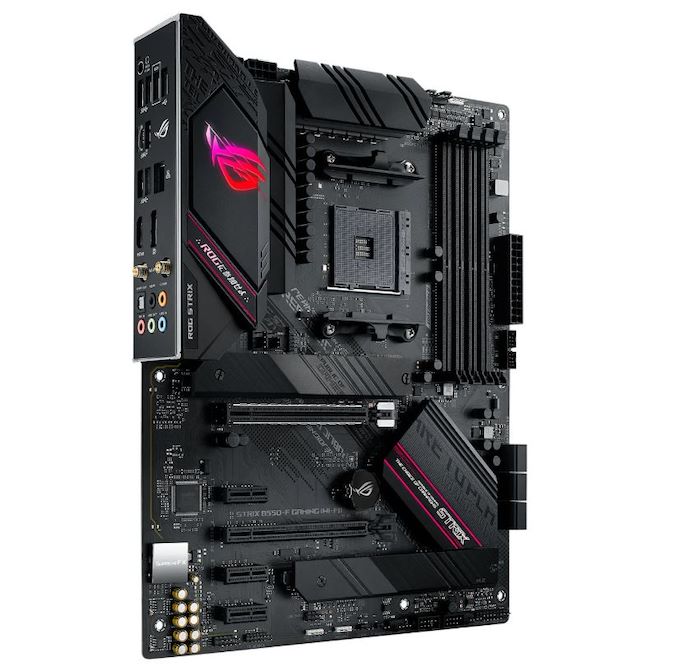The ASUS ROG Strix B550-F Gaming Wi-Fi Motherboard Review: Premium Value
by Gavin Bonshor on July 22, 2020 9:00 AM EST- Posted in
- Motherboards
- AMD
- Asus
- ROG
- AM4
- Strix
- Ryzen 3000
- Ryzen 3700X
- B550
- B550-F
ASUS ROG Strix B550-F Gaming Wi-Fi Conclusion
When AMD and motherboard vendors finally unveiled the B550 chipset, any potential conversational points were almost completely masked by discussions on the price. When a new B series chipset, that used to play in that $70-$200 region comes out *starting* at $165 and going beyond $300+, what else is there to talk about?? When delving deeper into the B550 product stack, as we did in our extensive B550 motherboard overview, it was clear that the majority of the models in the $200-300 price point are aimed at users that want or need premium audio and networking controllers. This is what ASUS has done with ROG Strix B550-F Gaming Wi-Fi, and it comes across as a polished example of a cost effective B550 motherboard,
Aimed at the mid-range, ASUS has equipped the Strix B550-F Gaming Wi-Fi with two M.2 slots, one with support for PCIe 4.0 x4 and one locked down to PCIe 3.0 x4. All of the boards PCIe 4.0 comes directly from the CPU, including the top full-length PCIe 4.0 x16 slot. The rest of the PCIe is driven by the B550 chipset which uses PCIe 3.0 lanes, including an additional full-length PCIe 3.0 x4 slot and three PCIe 3.0 x1 slots. One of the improvements over B450 is integrated support for USB 3.2 G2, in which ASUS has included two ports on the rear panel including a Type-C and Type-A.
Other interesting features include an Intel I225-V 2.5 GbE Ethernet controller and an Intel AX200 Wi-Fi 6 CNVi module which is generally found on more expensive X570 models; this is something which is becoming more mainstream in this price segment. It also includes a SupremeFX S1200A HD audio codec with a pair of amps which powers the onboard audio, and the codec itself does include EMI isolation which is a nice touch. The overall design is also interesting as it includes an all-black design with pink highlights on the rear panel cover and the chipset heatsink, which is very unconventional, but it blends in nicely and looks unique. Users looking to add more style can do so via three RGB headers, two regular and one addressable.
In our testing, the ASUS ROG Strix B550-F Gaming performed brilliantly in our system tests with the quickest POST time from any AM4 board we've tested with our Ryzen 3700X so far. The B550-F Gaming also had an impressive DPC latency result, with a massive advantage over other boards we've tested at default settings. In our CPU and game testing, the B550-F Gaming Wi-Fi was competitive. Our overclocking testing showed good results and tight VDroop control, with solid VRM thermals too. To put it mildly, the B550-F Gaming Wi-Fi has better VRM thermals than some X570 models costing double the price, which is a big win for ASUS here.

ASUS ROG Strix B550-F Gaming: Recommended
For $210 with Wi-Fi, or $190 without, ASUS provides a lot of quality and performance for the money. It puts to bed the expectation that B550 motherboards can't be as good quality as the X570 series models. Despite users expecting cheaper prices of B550, vendors look to have made improvements to the quality of the PCB to make sure the PCIe 4.0 implementation is optimal. There are lower cost B550 options available, but ASUS has a firecracker in the B550-F Gaming Wi-Fi and provides a solid alternative to X570.











40 Comments
View All Comments
Death666Angel - Wednesday, July 22, 2020 - link
So, single players games aren't a thing anymore? I game, but I don't play multiplayer modes or games.ZipSpeed - Wednesday, July 22, 2020 - link
I dunno, I'm not a competitive gamer by any means and I've been playing online via Wi-Fi for years with no issue. Maybe I'm just less sensitive to the variation because I honestly can't tell the difference wired and wireless.PeachNCream - Wednesday, July 22, 2020 - link
I haven't noticed a substantial difference, but there is a lot of hair splitting going on out there and it is well supported by marketing departments at hardware companies that want to land sales from people. Higher refresh rates, faster mouse polling, overclocking to gain like 2% more performance, Killer NICs that claim to give your game's data packets priority over other packets and so forth all appeal to people that feel like buying all of those things will make them more competitive so they get to teabag someone's corpse more often and feel proud of themselves when their only accomplishment in life is being at or around the top of a leader board. It's sad, but male competitiveness easy to exploit because the individual experiencing it is typically blind to it and will not think rationally about it. Why else to obese men purchase large pickup trucks or glitter bomb glowing computers except to feel empowered in some small way? The WiFi versus wired ethernet thing is just one more way to proclaim you feel superior to someone that doesn't care enough to throw a twisted pair cable across a room or two.CardiWAP - Tuesday, August 11, 2020 - link
Absolute rubbish.Play any fighting game and you can tell right away when somebody is on Wi-Fi. Same thing in shooters.
Wi-Fi really is awful for anything requiring quick action.
Fighting games are based on frames and you have to be aware at every single moment of the frame data of moves.
Any added latency, jitter or any hiccup and the things you thought should have worked (and would have worked in a low latency wired connection) doesn't anymore. You drop a combo, you fail to punish a move, you fail to party and you die.
This particular example that is familiar to me can be extended to any online game requiring quick action, reflexes and constant known data and behavior.
Not using WiFi in these online games is not about anything you've described. It's just about having the best online experience - meaning one closest to offline. And you obviously wreak havoc playing on WiFi it might also be a question of respect for people playing with/against you.
The part about high refresh rate monitor is as misinformed and far-fetched as the Wi-Fi one.
You simply need to drag a simple window in your favourite OS and switch between 60Hz and 144Hz to understand the wonders of the smoothness in high framerate gaming.
Moreover, the switch to flat screen panels really was in some instances a regression that is somewhat mitigated with high refresh rate panels (in the blur department).
Overclocking has been a core part of PC gaming for decades so I won't even bother going further than this.
You might have a leg to stand on regarding Killer NICs and their drivers but they don't jack up the price of the motherboards they are in so it doesn't matter anyway.
MrVibrato - Wednesday, July 22, 2020 - link
I didn't know that you spell ISP like "WiFI" in your corner of the world. ;-PGastec - Sunday, January 3, 2021 - link
WiFi "kills" more than just gaming performances, it's slower than Ethernet cable connection for everything. A WiFi connection between the computer and the router is useful in certain situations but we can't deny that there is a consistent propaganda campaign to convince the consumers to switch from Ethernet to wireless connections, for a good price of course. The more you buy, the more we profit, after all! :)DanNeely - Wednesday, July 22, 2020 - link
"USB 3.0 (5 Gbps) 2 x Type-A Header (2 x ports)"Type A headers are 2 ports, each so this should either be 1x header, or 4x ports.
Ryan Smith - Wednesday, July 22, 2020 - link
Thanks Dan. That's indeed 1 header.mooninite - Wednesday, July 22, 2020 - link
What about a test network performance? The I225-V has two bad revisions (v1 & v2) and there is no known way to know what version you will buy. A benchmark could confirm it.DanNeely - Wednesday, July 22, 2020 - link
If they're not making it explicit in the specsheet any test Gavin did would be of limited value since there would be nothing stopping Asus from having a silicon lottery where not all production runs use the same version of the controller.